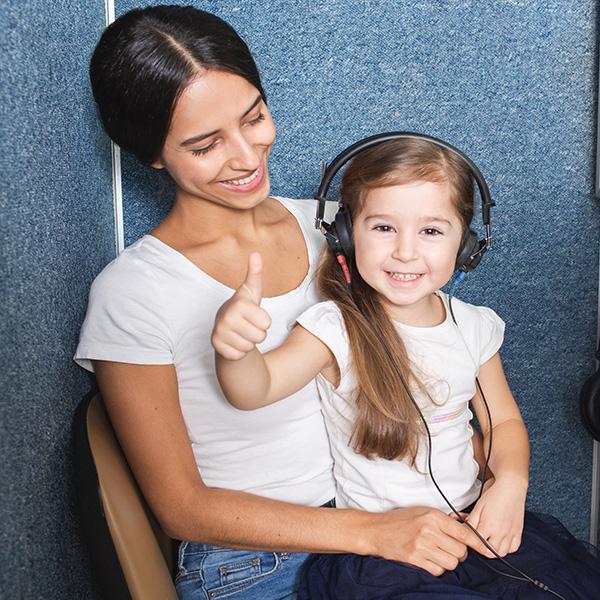Hearing Testing
Newborns and Infants
Otoacoustic Emissions (OAEs) are use to test a baby's hearing.
-
For this test, a miniature earphone and microphone are placed in the ear.
-
Sounds are played in the ear and a response is measured.
-
If a baby hears normally, an echo is reflected back into the ear canal and is measured by the microphone.
Auditory Brainstem Response Testing (ABR) is used when a more in-depth evaluation of hearing is needed.
-
For this test, electrodes are placed on the forehead and ears.
-
Sounds are presented through earphones and a response is recorded from the auditory nerve and brain in response to sound.
Children & Adults
Hearing is assessed using traditional testing methods.
-
A pure-tone test determines the faintest sound a person can hear at various frequency levels from low to high. Headphones are worn during this test so that each ear can be tested individually.
-
Visual Reinforcement Audiometry (VRA) testing is used for younger children who will not wear headphones or are too young to be trained to respond to tones. The child is trained to look for sounds being presented through speakers.
-
Speech testing is used to confirm pure-tone testing results and it determines the quietest level at which a person can hear and/or understand words.
-
Auditory Processing Disorder (APD) testing is used to see how the patient’s brain is processing auditory information. Tests are administered in a sound booth. Patients will have to listen and respond to a variety of auditory signals.
What is APD?
Auditory processing can be defined as “what we do with what we hear.”
Auditory processing disorders (APD) is when there is a deficit in processing what we hear, but it is not attributed to hearing loss or intellectual impairment. There is an interference with how the brain distinguishes and interprets sounds, especially speech.
Although APD is not a result of higher-order cognitive, language or related disorder, children with other language-learning difficulties such as dyslexia or ADD/ADHD may also have APD.
APD can only be diagnosed by a certified and specialized audiologist.
- Listening difficulties
- Appears to listen but doesn’t follow directions given orally
- Difficulty understanding speech in noisy environments
- Easily distracted
- Inconsistent responses to auditory stimuli
- Makes requests for repetition
- Academic struggles
- History of Otitis Media
- “I can’t understand what people are saying when it is noisy”
- “I hear, but I don’t understand.”
- “I can’t remember what I’m told - especially if it’s a lot of instructions.”
- “I have a terrible time trying to learn Spanish.”
- “I can’t seem to concentrate unless it’s very quiet in the room.”
- “If someone talks very quickly, I misunderstand what they say.”
- Age 7 and older
- English - native language
- Normal hearing
- Normal IQ
